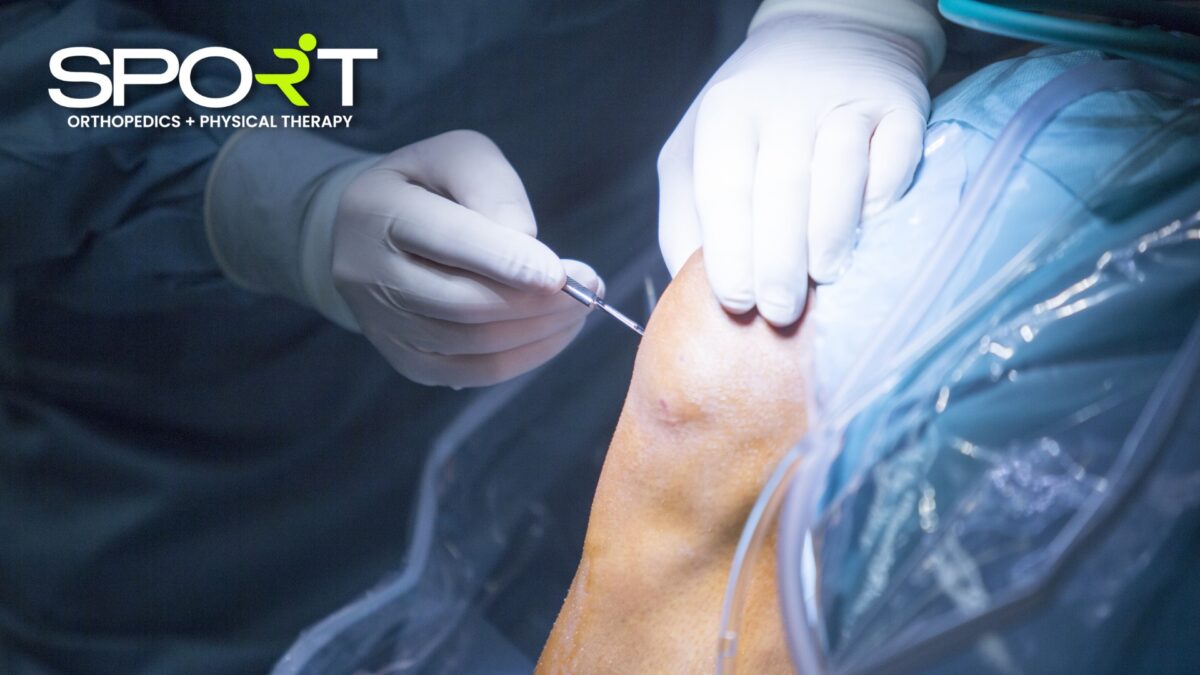Partial Knee Replacement Surgery in Dallas, Frisco, Plano and Wylie TX
What to Expect from Partial Knee Replacement Surgery
We depend on our knees for support and mobility, but when you’ve been suffering from knee pain, that can make even the easiest tasks difficult. If you’ve been experiencing pain and discomfort around your knee, it’s time to visit the orthopedic surgeons at SPORT Orthopedics + Physical Therapy. Our knee doctors are the best in the area and will evaluate your pain and provide you with a specialized treatment plan unique to your needs. You may be a candidate for partial knee replacement surgery.
If your knee pain is only in one area of your knee, you could be a candidate for partial knee replacement. To learn more about knee replacements, call (469) 200-2832 to schedule an appointment.
What Is a Partial Knee Replacement?
A partial or unicompartmental knee replacement is a surgical procedure where the orthopedic surgeon replaces one compartment damaged from knee osteoarthritis. The knee is made up of three different compartments: the medial compartment, the lateral compartment, and the patellofemoral compartment. If the damage is not localized to one compartment, your surgeon will most likely recommend a total knee replacement.
Partial vs Total Knee Replacement Surgery
Patients that only have knee osteoarthritis in one particular area of the knee are better candidates for a partial, or unicondylar knee replacement procedure. Partial knee replacement patients usually suffer from osteoarthritis in the medial compartment of the knee. The medial compartment is more prone to knee arthritis compared to the lateral compartment and patellofemoral compartment. If you’re experiencing knee pain in all three compartments of your knee, your surgeon will likely suggest a total knee replacement.
A partial knee replacement compared to a total knee replacement is less invasive which allows for a faster recovery.
Partial vs Bilateral Knee Replacement Surgery
Bilateral or double knee replacement occurs when an otherwise healthy patient is suffering from knee arthritis in both knees. To be a double knee replacement candidate, you must be physically fit, healthy, and committed to physical therapy. A bilateral knee replacement can be a partial or total knee replacement in both knees.
Patients that are candidates for double knee replacement surgery can either have a staged or simultaneous bilateral knee replacement.
A staged bilateral knee replacement replaces the knee joints in separate surgeries. The staged option is usually performed several months apart. It allows the knee to recover before replacing the other knee joint. Staged bilateral knee replacements also have fewer complications than simultaneous.
The surgeon will replace both knees during the same procedure during a simultaneous bilateral knee replacement. The benefit of this option is that there is only one hospital stay and rehabilitation. However, the procedure takes longer, and the recovery time is longer than a staged bilateral knee replacement.

Advantages of Partial Knee Replacement
Patients that meet the criteria for a partial knee replacement generally have good results following the procedure. A partial knee replacement is less invasive than a total knee replacement, allowing for a shorter recovery period. In addition to a quicker recovery, there are other benefits of having a partial knee replacement over a total knee replacement.
Advantages of Partial Knee Replacement Over Total Knee Replacement
The advantages of a partial versus total knee replacement are:
- Shorter recovery
- Less blood loss
- Less pain following surgery
- Lower risk of blood clots and infections
- Feels more natural
Since the bone, ligaments, and cartilage are not disturbed in the healthy areas of the knee joint, patients claim that partial knee replacement feels more natural compared to a total knee replacement because it better preserves the natural function of the knee.
Who Is a Good Candidate for Partial Knee Replacement Surgery?

To be a candidate for a unicompartmental knee replacement, your knee osteoarthritis must only affect one knee compartment. If non-surgical treatments no longer relieve your knee arthritis, your orthopedic surgeon may recommend a partial knee replacement.
The ideal partial knee replacement patient meets the following criteria:
- Has minimal knee deformity
- Good range of motion
- Over 60 years of age
- Not very active
- BMI of 35 or less (your height to weight ratio)
If you have inflammatory arthritis, ligament damage, and/or significant knee stiffness, you may not be eligible for a partial knee replacement.
Are There Age Restrictions for Getting Partial Knee Replacement Surgery?
There are no strict age restrictions for undergoing partial knee replacements. Before, it was only recommended for patients over 60 that lived sedentary lifestyles. Now younger and active individuals have been considered for partial knee replacements. Candidates must also meet the criteria listed above.
Is a Partial Knee Replacement Worth It?
A partial, unicompartmental knee replacement is worth having if you’re suffering from knee pain confined to one of the three areas of the knee. A partial knee replacement can improve your quality of life by helping you regain mobility. Patients with partial knee replacement report that their knee bends and moves much more naturally than after a total knee replacement. Being able to move your knee more naturally contributes to improved mobility.
If the time does come that you need a total knee replacement, you are still eligible if you’ve had a partial knee replacement.
How to Prepare for Partial Knee Replacement Surgery

In preparation for your knee replacement, you’ll want to prepare your home. Following your procedure might be difficult, so moving furniture and rugs can help you avoid tripping hazards. Also, you’ll want to prepare your recovery space to have everything you need within reach, like your medications, phone, etc. If you live in a two-story home, you may want to consider moving everything you need to the lower level. Adding safety railings in the bathroom to the shower and toilet is also recommended so maneuvering is easier on your recovering knee.
Before Your Surgery
Before your partial knee replacement, your orthopedic surgeon will perform an exam to determine if you’ll be a good candidate for unicompartmental knee replacement. During the exam, your doctor will try to locate the area of the knee where you’re experiencing pain. If it’s localized to one of the knee compartments, usually the medial compartment, then you will most likely be a good candidate for partial knee replacement.
If the pain is throughout your entire knee joint or under your knee cap, then a total knee arthroplasty replacement will most likely be recommended. In addition to locating the source of your pain, your doctor will evaluate the quality of your ligaments and your range of motion. Factors like torn ligaments or a weakened knee will make a better candidate for a total knee replacement rather than a partial. Your doctor will also order an X-Ray before surgery to study the extent of the knee osteoarthritis damage.
Anesthesia Options
Before surgery, the anesthesiologist will discuss your anesthesia options. These options include:
- Regional anesthesia is where the patient is only numb for the lower half of the body and remains awake during the procedure.
- Nerve blocks are a variation of regional anesthesia where the specific nerve or nerves are injected with numbing medication to block pain in particular areas of the body. Nerve blocks can also be used with general anesthesia or spinal.
- General anesthesia is when the patient is completely put to sleep.
- Spinal anesthesia is when the patient is awake but numb from the waist down. This is a type of regional anesthesia.
The surgical procedure itself lasts between one to two hours. Once the joint is inspected, your orthopedic surgeon will examine the knee cartilage once they’ve made the incision to ensure the damage is located in one area. If the damage is more substantial, the surgeon may forgo the partial knee replacement and perform a total knee replacement instead. Before your surgery, the surgeon will discuss this option with you and ensure you are fine with this.
Steps of a Partial Knee Replacement
The partial knee replacement will happen in three steps:
- Bone prep: The surgeon will remove the cartilage from the damaged area of your knee with a special saw.
- Bone measurements and implant positioning: Once the damaged portion of the knee is removed, the surgeon will replace it with a metal covering that mimics the joint. This metal part will either be set in place with cement or fit to the bone to grow around the implant, holding it in place.
- Spacer: Once the metal compartment is in place, the surgeon will insert a plastic spacer for a smooth, gliding surface.
Once the procedure is over, you’ll be moved to recovery, where you’ll be monitored for any side effects from the surgery or anesthesia. You’ll be allowed to go home, or you will be kept overnight for observation.
How Painful Is Partial Knee Replacement Surgery?
While all surgeries involve some level of pain, patients with partial knee replacement experience less pain and stiffness than a total knee replacement. Since partial knee replacement is minimally invasive, it only disturbs the area of the knee that is affected, which contributes to less pain and quicker recovery.
Partial Knee Replacement Recovery Time

After knee surgery, you should be able to move your knee the same day. You should also be able to go home the same day as your surgery unless you have a medical condition that makes the surgeon want to keep you overnight. Your doctor will prescribe medication to protect you against blood clots, both while you’re in the hospital and possibly for a short time after. Moving your knee quickly after surgery is also important in preventing blood clots.
Once discharged from the hospital, you’ll work with a Dallas physical therapist for two weeks to a month. You should also regain normal knee functions quickly and with less pain than you would experience with a total knee replacement.
Patients should be able to return to normal activities in six to eight weeks following surgery. It’s recommended to avoid high-impact exercises and running or jogging since the replacement piece has a bearing surface that is susceptible to wear and tear. Avoiding common mistakes after knee replacement surgery is extremely important for your health and recovery.
How Soon Can You Walk After a Partial Knee Replacement?
After a partial knee replacement, you must work with your physical therapist and follow their recommended exercises as soon as possible. Most patients are able to get up and walk on the very same day after a partial or full knee replacement. Following the guidelines for your physical therapy is critical to caring for your knee after surgery. Many patients can walk without any assistance after two to three weeks after surgery.
In fact, patients can even participate in low-impact activities or sports like yoga, walking, swimming, hiking, skiing, and tennis. The professionals at SPORT will have you back to living your active lifestyle as quickly as possible following your procedure.
How Long Does a Partial Knee Replacement Last?
Partial knee replacements last between 10 to 15 years, which is similar to the longevity of a total knee replacement.
What Is the Success Rate of Partial Knee Replacements?
The success rate after a partial knee replacement is between 90% and 95%, which means there is at least a 90% chance that your partial replacement will still function properly in 10 years.
Potential Complications of a Partial Knee Replacement

No matter what type of surgical procedure you have, there will always be a potential for risks and complications. Before your partial joint replacement surgery, your orthopedic surgeon will discuss the potential complications you could face. Following their recovery instructions is essential to avoid infections or other possible complications.
The most common complications after a partial knee replacement are:
- Infection: Your surgical site can become infected days or even years following your surgical procedure. It’s important to take the antibiotics you’re prescribed in the days leading up to your surgery and following your surgery to prevent infection. Less than 1% of patients experience serious infections.
- Blood clots can form in the pelvis or leg veins following knee replacement. After your surgery, your doctor may prescribe you blood thinners to help prevent clots. Moving your knee after surgery is also key to preventing blood clots.
- Injured nerves or blood vessels: Although rare, blood vessels or nerves can be damaged during surgery.
- Complications from anesthesia: The anesthesiologist will discuss the difficulties you may experience after surgery. These are usually mild and don’t last very long.
- Pain doesn’t improve: Continued stiffness or pain. Mobility does not improve.
Partial Knee Replacement Failure Symptoms
Common symptoms of a failed partial knee replacement are decreased function in the knee joint, pain, swelling, or stiffness in the knee joint and knee instability. Postoperative pain and swelling can mean the replacement has become loose or infected. The area of the pain can either be the entire knee (generalized) or in only one compartment (localized).
If your knee function has declined rather than improved, you may experience limping, instability, or stiffness. If this continues, you may have to undergo knee revision surgery. However, complications like this following a unicompartmental knee replacement occur much less frequently than with total knee arthroplasty.
Contact SPORT Orthopedics + Physical Therapy Today
If osteoarthritis of the knee is causing you pain that makes you miss out on activities you once loved, you might be a good candidate for a partial knee replacement. The orthopedic surgeons at SPORT Orthopedics + Physical Therapy are the best in Dallas. Once they determine your course of action, you’ll be back to living life pain-free in no time. Begin your pain-free journey today by calling (469) 200-2832 or scheduling an appointment online.


